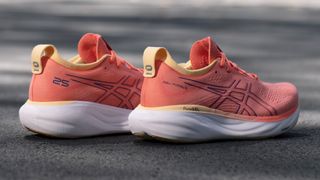What is EVA foam in running shoes?
我们的心和鞋底夹层的最爱running shoes to answer your questions about EVA foam

EVA foam is to running shoes asDWR coatingis towaterproof jackets– all but ubiquitous. These days, if you’re looking for a lightweight running shoe or even ahiking bootwith plenty of cushioning for long days on the trail, you’re almost definitely looking at an EVA foam midsole. But what is EVA foam in shoes anyway? Is it better than rubber, which used to be commonplace in footwear, and how long does it last? We get right into the heart and midsoles of your running shoes to answer these questions.

What is EVA foam?
EVA stands for ethylene-vinyl acetate (also known as PEVA, which stands for poly ethylene-vinyl acetate) and is a thermoplastic more commonly known as foam rubber or expanded rubber. There are three different types of EVA made with different amounts of vinyl acetate. The more vinyl acetate EVA is composed of, the more it presents like rubber – soft and flexible. For this reason, it has become very popular in the midsoles ofroad running shoeslike theHoka Solimar, which we found created an almost “crash pad” like effect when we ran in them andtrail running shoeslike theMerrell Skyfire, which are extremely lightweight for those long runs.
We’ve encountered it in loads of other sporting equipment too, fromsnowshoeslike theCrescent Moon Lunasto the handles oftrekking polessuch as in theBlack Diamond Distance Carbon Zs. Being free of animal products, it’s also common invegan footwear.

Which is better: EVA or rubber?
As always, the answer here depends on what you’re doing with it, and also whether you’re talking about natural or synthetic rubber. It’s probably easier just to look at some of the key characteristics of EVA to explain why it’s often preferred over rubber in running shoes. Shoe manufacturers love EVA because it’s lightweight, soft, flexible and a great shock absorber, so it’s the better choice for running shoe midsoles, but if it’s used in the outsoles, it’s not as grippy or durable as synthetic rubber and it may be too soft for some of your endeavors where you want a stiffer sole. Natural rubber has great grip and is still used for indoor court shoes, but it is also heavy, which isn’t ideal when you want to move fast.
Is EVA foam recyclable?
Like most plastic products, once your running shoes made using EVA foam make it to the landfill, they will be there forever. Though it is a material that can technically be recycled, it is very unlikely that you will find someone who can do so, and more research and investment needs to be done on this topic to make sure that we’re not just filling up the planet with foam.

How long does EVA foam last in shoes?
How long anything lasts depends on what you’re doing with it. As we mentioned, it doesn’t biodegrade so if you never wear your shoes with EVA foam, the midsoles would probably last forever. When you’re putting in some miles in them, however, you will find that it loses its cushioning and breaks down over time and you’ll need toreplace your running shoesevery 300 - 500 miles if you still want that cushion.
Is EVA foam safe for footwear?
Any time you’re wearing clothing or shoes made usingsynthetic materials, it’s fair to ask if there is any risk to your health. The good news is that EVA foam does not contain chloride, so it’s thought to be safer than similar alternatives. The疾病预防控制中心(opens in new tab)hasn’t found it to be carcinogenic, and while it notes that it can be absorbed through the skin, it is thought to be easily broken down by your body and they make no mention as to whether you can absorb it from your shoes and clothing.
Advnture Newsletter
All the latest inspiration, tips and guides to help you plan your next Advnture!
Julia Clarke is a staff writer for Advnture.com and the author of the bookRestorative Yoga for Beginners. She loves to explore mountains on foot, bike, skis and belay and then recover on the the yoga mat. Julia graduated with a degree in journalism in 2004 and spent eight years working as a radio presenter in Kansas City, Vermont, Boston and New York City before discovering the joys of the Rocky Mountains. She then detoured west to Colorado and enjoyed 11 years teaching yoga in Vail before returning to her hometown of Glasgow, Scotland in 2020 to focus on family and writing.
